Chapter: Artificial Intelligence
Types of Knowledge Representation
Types of Knowledge Representation
Knowledge can be represented in different ways. The structuring of
knowledge and how designers might view it, as well as the type of structures
used internally are considered. Different knowledge representation techniques
are
a.
Logic
b.
Semantic Network
c.
Frame
d.
Conceptual Graphs
e.
Conceptual Dependency
f.
Script
Logic
A logic is a formal language, with precisely defined syntax and
semantics, which supports sound inference. Different logics exist, which allow
you to represent different kinds of things, and which allow more or less
efficient inference. The logic may be different types like propositional logic,
predicate logic, temporal logic, description logic etc. But representing
something in logic may not be very natural and inferences may not be efficient.
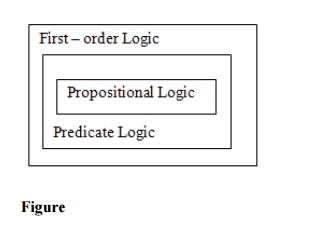
Semantic Network
A semantic network is a graphical knowledge representation technique.
This knowledge representation system is primarily on network structure. The
semantic networks were basically developed to model human memory. A semantic
net consists of nodes connected by arcs. The arcs are defined in a variety of
ways, depending upon the kind of knowledge being represented.
The main idea behind semantic net is that the meaning of a concept
comes, from the ways in which it is connected to other concepts. The semantic
network consists of different nodes and arcs. Each node should contain the
information about objects and each arc should contain the relationship between
objects. Semantic nets are used to find relationships among objects by
spreading activation about from each of two nodes and seeing where the
activation met this process is called intersection search.
For example: Ram is a boy.

Semantic network by using
Instances
The semantic network based knowledge representation mechanism is useful
where an object or concept is associated with many attributes and where
relationships between objects are important. Semantic nets have also been used
in natural language research to represent complex sentences expressed in
English. The semantic representation is useful because it provides a standard
way of analyzing the meaning of sentence. It is a natural way to represent
relationships that would appear as ground instances of binary predicates in
predicate logic. In this case we can create one instance of each object. In
instance based semantic net representations some keywords are used like: IS A,
INSTANCE, AGENT, HAS-PARTS etc.
Consider the following examples:
1. Suppose we have to represent the sentence ŌĆ£Sima is a girlŌĆØ.
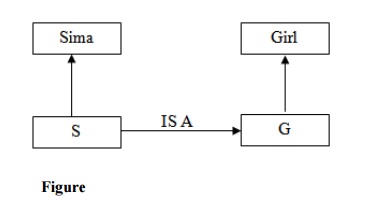
2. Ram is taller than Hari
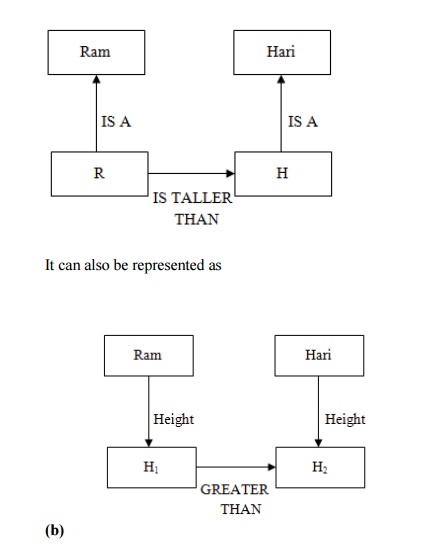
3.
ŌĆ£Mouse is a Rodent and Rodent is
a mammal. Mouse ha s teeth and etas grassŌĆØ. Check whether the sentence mammal
has teeth is valid or not. ]
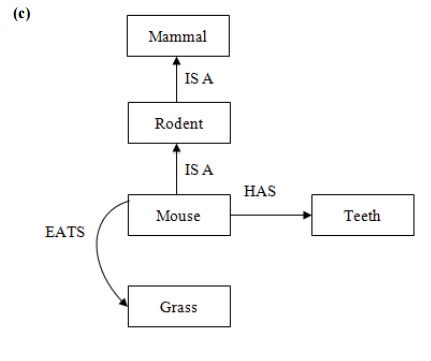
Partitioned Semantic Network
Some complex sentences are there which cannot be represented by simple
semantic nets and for this we have to follow the technique partitioned semantic
networks. Partitioned semantic net allow for
1.
Propositions to be made without
commitment to truth.
2.
Expressions to be quantified.
In partitioned semantic network, the network is broken into spaces which
consist of groups of nodes and arcs and regard each space as a node.
Let us consider few examples.
Draw the partitioned semantic network structure for the followings:
a) Sima is eating an apple.
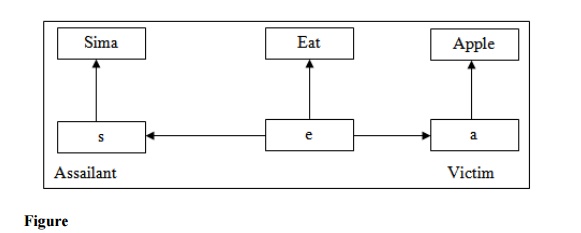
b) All Sima are eating an apple.
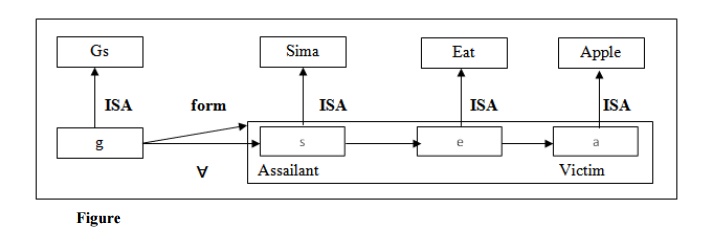
c) All Sima are eating some apple.
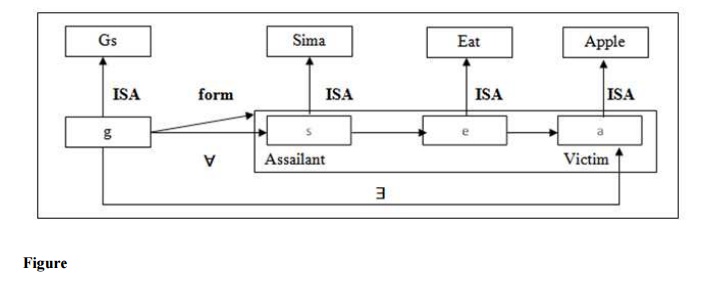
d) All men are mortal
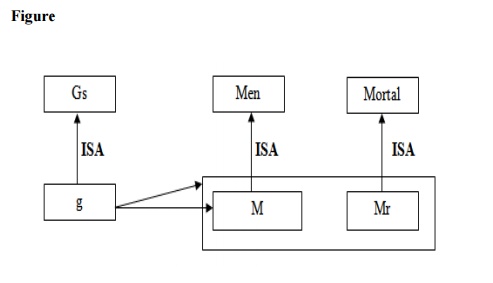
e)
Every dog has bitten a shopkeeper
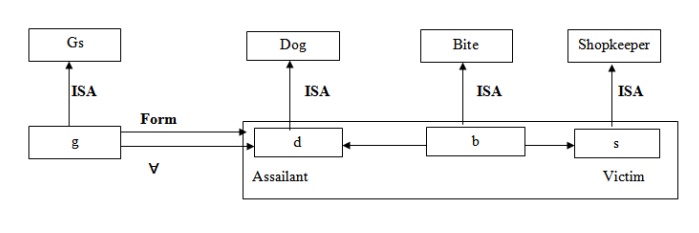
f)
Every dog in town has bitten a
shopkeeper.

NOTE: On the above semantic network structures, the instance ŌĆ£IS AŌĆØ is used.
Also two terms like assailant and
victim are used. Assailant means ŌĆ£by which the work is doneŌĆØ and that of victim
refers t o ŌĆ£on which the work is appliedŌĆØ. Another term namely GS, which refers
to General Statement. For GS, make a node g which is an instance of Gs. Every
element will have at least two attributes. Firstly, a form that states which a
relation is being asserted. Secondly, one or more for all (") or
there exists ($) connections which represent universally quantifiable variables.
FRAME
A frame is a collection of attributes and associated values that
describe some entity in the world. Frames are general record like structures
which consist of a collection of slots and slot values. The slots may be of any
size and type. Slots typically have names and values or subfields called
facets. Facets may also have names and any number of values. A frame may have
any number of slots, a slot may have any number of facets, each with any number
of values. A slot contains information such as attribute value pairs, default
values, condition for filling a slot, pointers to other related frames and
procedures that are activated when needed for different purposes. Sometimes a
frame describes an entity in some absolute sense, sometimes it represents the
entity from a particular point of view. A single frame taken alone is rarely
useful. We build frame systems out of collection of frames that are connected
to each other by virtue of the fact that the value of an attribute of one frame
may be another frame. Each frame should start with an open parenthesis and
closed with a closed parenthesis.
Syntax of a frame
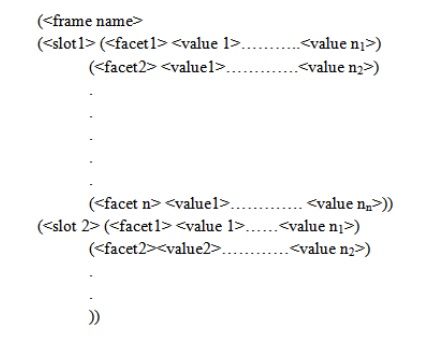
Let us consider the below examples.
1) Create a frame of the person
Ram who is a doctor. He is of 40. His wife name is Sita. They have two children
Babu and Gita. They live in 100 kps street in the city of Delhi in India. The
zip code is 756005.
(Ram
(PROFESSION (VALUE Doctor))
(AGE (VALUE 40))
(WIFE (VALUE Sita))
(CHILDREN (VALUE Bubu, Gita))
(ADDRESS
(STREET (VALUE 100 kps))
(CITY(VALUE Delhi))
(COUNTRY(VALUE India))
(ZIP (VALUE 756005))))
2) Create a frame of the person
Anand who is a chemistry professor in RD WomenŌĆÖs College. His wife name is
Sangita having two children Rupa and Shipa.
(Anand
(PROFESSION (VALUE Chemistry Professor))
(ADDRESS (VALUE RD WomenŌĆÖs College))
(WIFE (VALUE Sangita))
(CHILDREN(VALUE RupaShipa)))
3) Create
a frame of the person Akash who has a white maruti car of LX-400 Model. It has 5
doors. Its weight is 225kg, capacity is 8, and mileage is 15 km /lit.
(Akash
(CAR (VALUE Maruti))
(COLOUR (VALUE White))
(MODEL (VALUE LX-400))
(DOOR (VALUE 5))
(WEIGHT (VALUE 225kg))
(CAPACITY (VALUE 8))
(MILAGE (VALUE 15km/lit)))
The frames can be attached with another frame and can create a network
of frames. The main task of action frame is to provide the facility for
procedural attachment and help in reasoning process. Reasoning using frames is
done by instantiation. Instantiation process begins, when the given situation
is matched with frames that are already in existence. The reasoning process
tries to match the current problem state with the frame slot and assigns them
values.The valuesassigned to the slots depict a particular situation and by
this, the reasoning process moves towards a goal. The reasoning process can be
defined as filling slot values in frames.
Conceptual Graphs
It is a knowledge representation technique which consists of basic
concepts and the relationship between them. As the name indicates, it tries to
capture the concepts about the events and represents them in the form of a
graph. A concept may be individual or generic. An individual concept has a type
field followed by a reference field. For example person : Ram. Here person
indicates type and Ram indicates reference.
An individual concept should be represented within a rectangle in
graphical representation and within a square bracket in linear representation.
The generic concept should be represented within an oval in graphical
representation and within a parenthesis in linear representation. Conceptual
graph is a basic building block for associative network. Concepts like AGENT,
OBJECT, INSTRUMENT, PART are obtained from a collection of standard concepts.
New concepts and relations can be defined from these basic ones. These are also
basic building block for associative network. A linear conceptual graph is an
elementary form of this structure. A single conceptual graph is roughly
equivalent to a graphical diagram of a natural language sentence where the
words are depicted as concepts and relationships.
Consider an example
ŌĆ£Ram is eating an apple ŌĆ£
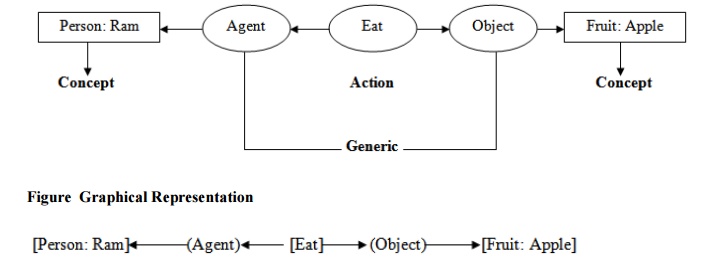
Conceptual Dependency
It is an another knowledge representation technique in which we can
represent any kind of knowledge. It is based on the use of a limited number of
primitive concepts and rules of formation to represent any natural language
statement. Conceptual dependency theory is based on the use of knowledge
representation methodology was primarily developed to understand and represent
natural language structures. The conceptual dependency structures were
originally developed by Roger C SChank in 1977.
If a computer program is to be developed that can understand wide
phenomenon represented by natural languages, the knowledge representation
should be powerful enough to represent these concepts. The conceptual
dependency representation captures maximum concepts to provide canonical form
of meaning of sentences. Generally there are four primitives from which the
conceptual dependency structure can be described. They are
a. ACTS : Actions
b. PPs : Objects (Picture Producers)
c. AAs : Modifiers of Actions (Action Aiders)
d. Pas : Modifiers of PPs (Picture Aiders)
e. TS : Time of action
Conceptual dependency provides both a structure and a specific set of
primitives at a particular level of granularity, out of which representation of
particular pieces of information can be constructed.
For example

Where ŌåÉ: Direction of dependency
Double arrow indicates two way link between actor
and action.
P: Past Tense
ATRANS: One of the primitive acts used by the
theory
O: The objective case relation
R: Recipient case Relation
In CD, representation of actions are built from a
set of primitive acts.
1)
ATRANS: Transfer of an abstract
relationship (give, accept, take)
2)
PTRANS: Transfer the physical location of
an object ( Go, Come, Run, Walk)
3)
MTRANS: Transfer the mental information
(Tell)
4)
PROPEL: Application of physical force to
an object (push, pull, throw)
5)
MOVE: Movement of a body part by its
owner (kick).
6)
GRASP: Grasping of an object by an
action (clutch)
7)
INGEST: Ingestion of an object by an
animal (eat)
8)
EXPEL: Expel from an animal body (cry)
9)
MBUILD: Building new information out of
old (decide)
10)
SPEAK: Production of sounds (say)
ATTEND: Focusing of a sense organ towards a stimulus (Listen)
The main goal of CD representation is to capture the implicit concept of
a sentence and make it explicit. In normal representation of the concepts,
besides actor and object, other concepts of time, location, source and
destination are also mentioned. Following conceptual tenses are used in CD
representation.
1) O: Object case relationship
2) R: Recipient case relationship
3) P : Past
4) F : Future
5) Nil : Present
6) T : Transition
7) Ts : Start Transition
8) Tf : Finisher Transition
9) K : Continuing
10) ? : Interrogative
11) / : Negative
12) C : Conditional
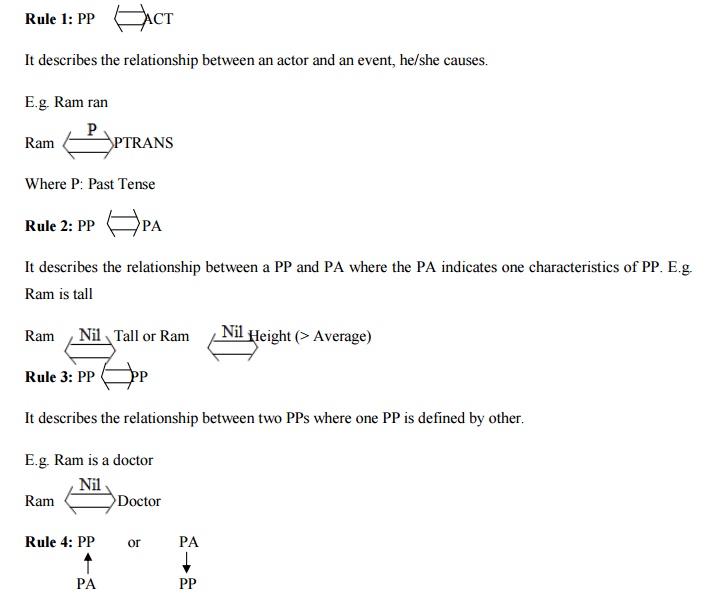
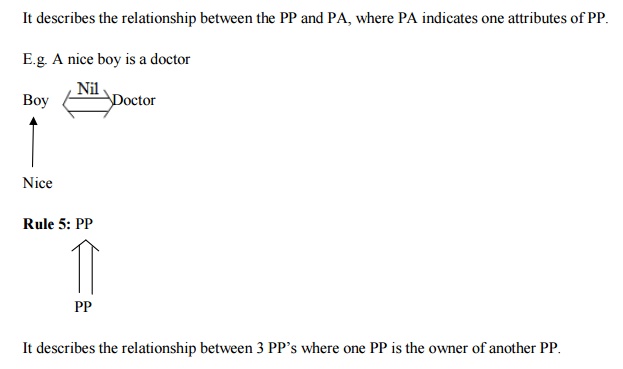
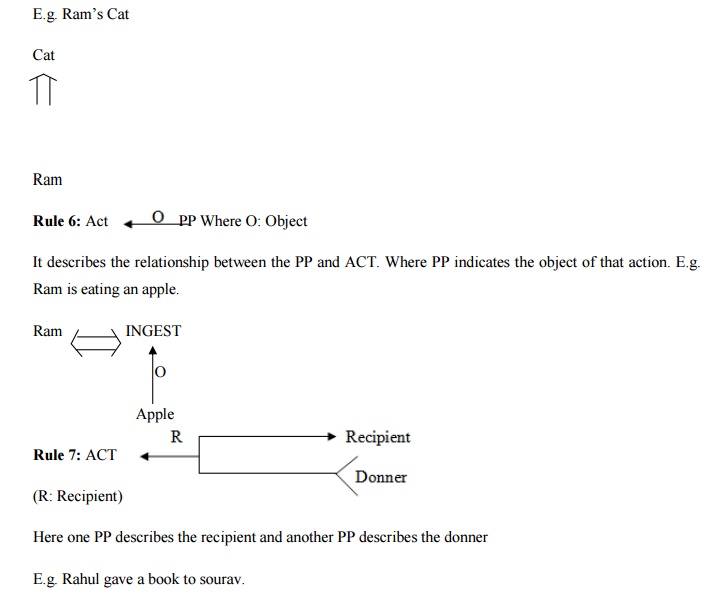

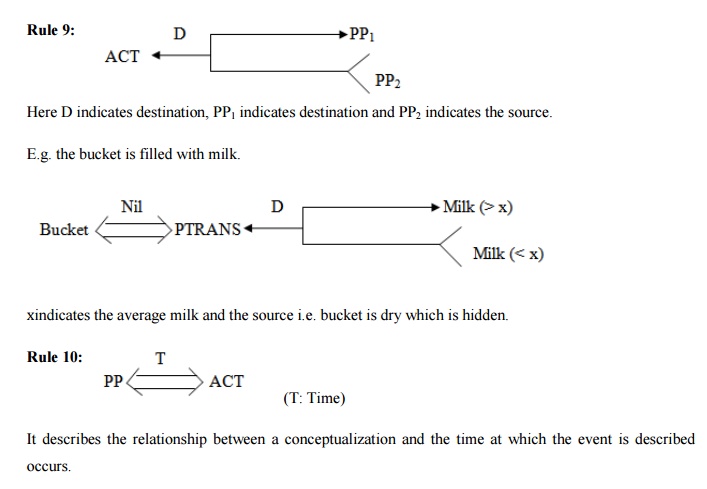
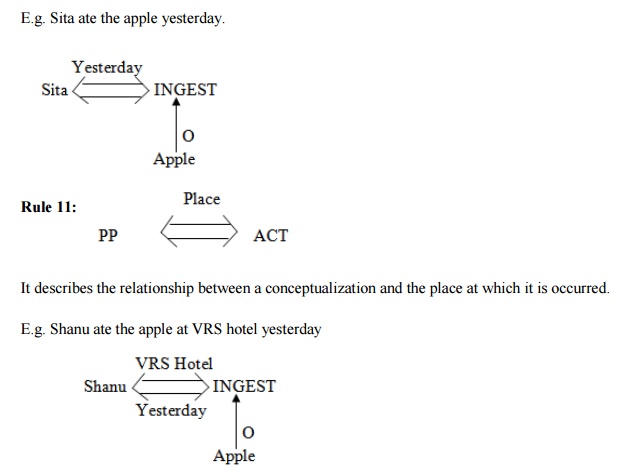
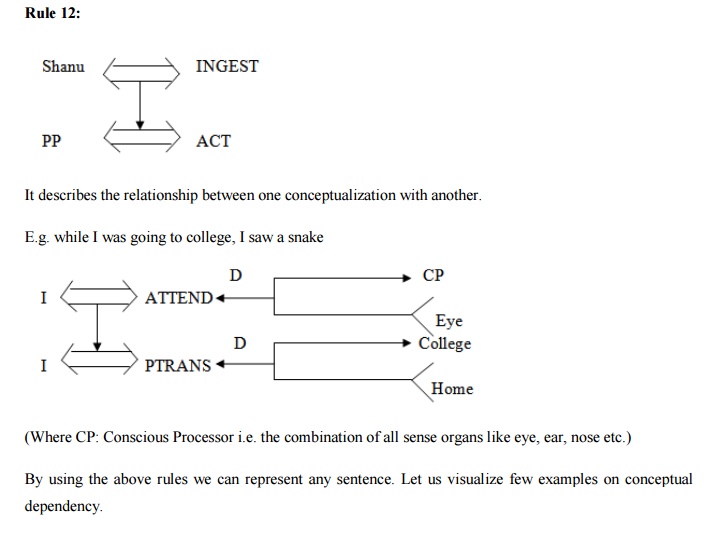
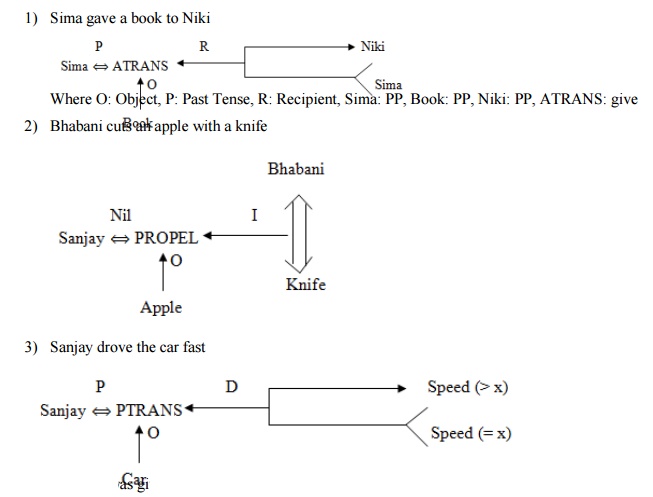


SCRIPT
It is an another knowledge representation technique. Scripts are frame
like structures used to represent commonly occurring experiences such as going
to restaurant, visiting a doctor. A script is a structure that describes a
stereotyped sequence of events in a particular context. A script consist of a
set of slots. Associated with each slot may be some information about what
kinds of values it may contain as well as a default value to be used if no
other information is available. Scripts are useful because in the real world,
there are no patterns to the occurrence of events. These patterns arise because
of clausal relationships between events. The events described in a script form
a giant casual chain. The beginning of the chain is the set of entry conditions
which enable the first events of the script to occur. The end of the chain is
the set of results which may enable later events to occur. The headers of a
script can all serve as indicators that the script should be activated.
Once a script has been activated, there are a variety of ways in which
it can be useful in interpreting a particular situation. A script has the
ability to predict events that has not explicitly been observed. An important
use of scripts is to provide a way of building a single coherent interpretation
from a collection of observation. Scripts are less general structures than are
frames and so are not suitable for representing all kinds of knowledge. Scripts
are very useful for representing the specific kinds of knowledge for which they
were designed.
A script has various components like:
1)
Entry condition: It must be true before the
events described in the script can occur. E.g. in a restaurant script the entry condition must be the customer should
be hungry and the customer has money.
2)
Tracks: It specifies particular position
of the script e.g. In a supermarket script the tracks may be cloth gallery, cosmetics gallery etc.
3)
Result: It must be satisfied or true
after the events described in the script have occurred. e.g. In a restaurant script the result must be true if the
customer is pleased. The customer has less money.
4)
Probs: It describes the inactive or dead
participants in the script e.g. In a supermarket script, the probes may be clothes, sticks, doors,
tables, bills etc.
5) Roles: It specifies the
various stages of the script. E.g. In a restaurant script the scenes may be
entering, ordering etc.
Now let us look on a movie script description according to the above
component.
a) Script name : Movie
b) Track : CINEMA HALL
c) Roles : Customer(c), Ticket seller(TS), Ticket
Checker(TC), Snacks
Sellers (SS)
d) Probes : Ticket, snacks, chair, money, Ticket,
chart
e) Entry condition : The customer has money
The customer has
interest to watch movie.
6) Scenes:
a. SCENE-1 (Entering into the
cinema hall)
CPTRANS C into the cinema hall
C ATTEND eyes towards the ticket counter C PTRANS C towards the ticket
counters C ATTEND eyes to the ticket chart
C MBUILD to take which class ticket C MTRANS TS for ticket
C ATRANS money to TS
TS ATRANS ticket to C
b. SCENE-2 (Entering into the
main ticket check gate)
C PTRANS C into the queue of the gate C ATRANS ticket to TC
TC ATTEND eyes onto the ticket
TC MBUILD to give permission to
C for entering into the hall
TC ATRANS ticket to C
C PTRANS C into the picture
hall.
c.
SCENE-3 (Entering into the picture hall)
CATTEND eyes into the chair
TC SPEAK where to sit
C
PTRANS C towards the sitting
position
C
ATTEND eyes onto the screen d. SCENE-4 (Ordering snacks)
C
MTRANS SS for snacks
SS
ATRANS snacks to C
C
ATRANS money to SS
C
INGEST snacks e. SCENE-5 (Exit)
C
ATTEND eyes onto the screen till
the end of picture
C MBUILD
when to go out of the hall
C PTRANS
C out of the hall
7)
Result:
The customer is happy
The customer has less money
Example 2: Write a script of
visiting a doctor in a hospital
1) SCRIPT_NAME : Visiting a doctor
2) TRACKS : Ent specialist
3) ROLES : Attendant (A), Nurse(N), Chemist (C), Gatekeeper(G), Counter
clerk(CC), Receptionist(R), Patient(P), Ent specialist Doctor (D), Medicine
Seller (M).
4) PROBES : Money, Prescription, Medicine, Sitting chair, DoctorŌĆÖs
table, Thermometer, Stetho scope, writing pad, pen, torch, stature.
5) ENTRY CONDITION: The patient need consultation. DoctorŌĆÖs visiting
time on.
6)
SCENES:
a. SCENE-1 (Entering into the hospital)
PPTRANS P into hospital
P
ATTEND eyes towards ENT
department
P
PTRANS P into ENT department
P
PTRANS P towards the sitting
chair b. SCENE-2 (Entering into the
DoctorŌĆÖs Room)
P
PTRANS P into doctorŌĆÖs room
P
MTRANS P about the diseases
P
SPEAK D about the disease
D
MTRANS P for blood test, urine
test
D
ATRANS prescription to P
P
PTRANS prescription to P.
P
PTRANS P for blood and urine test
c. SCENE-3 (Entering into the Test Lab)
P
PTRANS P into the test room
P
ATRANS blood sample at collection
room
P
ATRANS urine sample at collection
room
P ATRANS the examination reports
d. SCENE-4 (Entering to the DoctorŌĆÖs room with
Test reports)
P
ATRANS the report to D
D ATTEND
eyes into the report
D MBUILD
to give the medicines
D SPEAK
details about the medicine to P
P ATRANS
doctorŌĆÖs fee
P
PTRANS from doctorŌĆÖs room
e. SCENE-5 (Entering towards medicine shop)
P
PTRANS P towards medicine counter
P ATRANS
Prescription to M
M ATTEND
eyes into the prescription
M MBUILD
which medicine to give
M ATRANS
medicines to P
P ATRANS
money to M
P
PTRANS P from the medicine shop
7)
RESULT:
The patient has less money
Patient has prescription and medicine.
Advantages And Disadvantages Of
Different Knowledge Representation
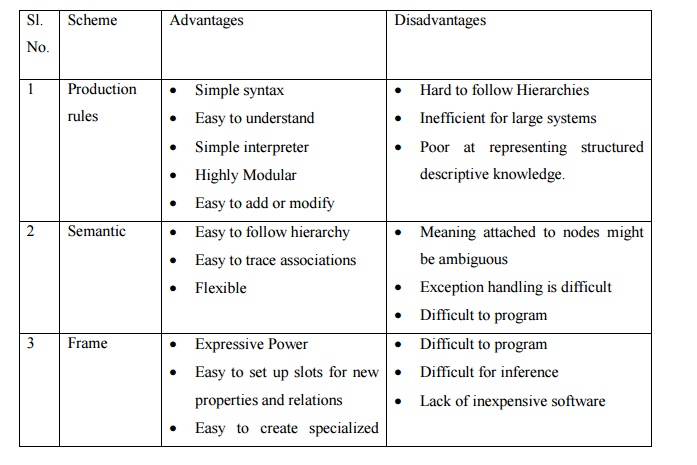
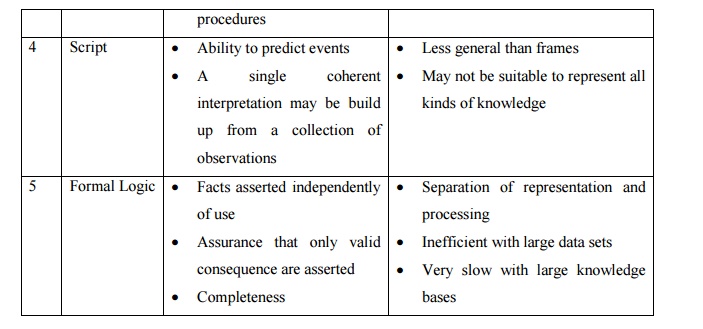
Related Topics